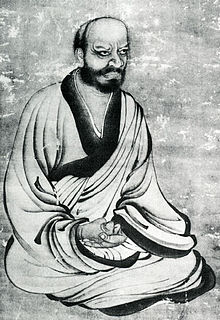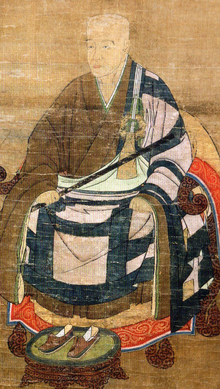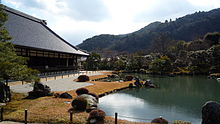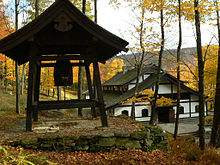Rinzai school
| Part of a series on |
| Zen Buddhism |
|---|
 |
| Part of a series on |
| Buddhism in Japan |
|---|
 |
The Rinzai school (
History

Rinzai is the Japanese line of the Chinese Linji school of Chan Buddhism, which was founded during the Tang dynasty by Linji Yixuan (Japanese: Rinzai Gigen).


Kamakura period (1185–1333)
Though there were several attempts to establish Rinzai lines in Japan, it first took root in a lasting way through the efforts of the monk
Rinzai Zen was established in Japan as the samurai rose to power. Along with early imperial support, Rinzai came to enjoy the patronage of this newly ascendant warrior class.[citation needed]
Muromachi (or Ashikaga) period (1336–1573)
During the
Five Mountain System
In the beginning of the Muromachi period, the Five Mountain System (Gozan) system was fully worked out. The final version contained five temples of both Kyoto and Kamakura, presided over by Nanzen-ji. A second tier of the system consisted of Ten Temples. This system was extended throughout Japan, effectively giving control to the central government, which administered this system.[4] The monks, often well educated and skilled, were employed by the shōgun for the governing of state affairs.[5]
| Kyoto | Kamakura | |
|---|---|---|
| First Rank | Tenryū-ji | Kenchō-ji |
| Second Rank | Shōkoku-ji | Engaku-ji |
| Third Rank | Kennin-ji | Jufuku-ji |
| Fourth Rank | Tōfuku-ji | Jōchi-ji |
| Fifth Rank | Manju-ji | Jōmyō-ji
|
Rinka-monasteries
Not all Rinzai Zen organisations were under such strict state control. The Rinka monasteries, which were primarily located in rural areas rather than cities, had a greater degree of independence.[6] The Ōtōkan lineage, which centered on Daitoku-ji, also had a greater degree of freedom. It was founded by Nanpo Shōmyō, Shūhō Myōchō, and Kanzan Egen.[7] A well-known teacher from Daitoku-ji was Ikkyū.[3]
Another Rinka lineage was the Hotto lineage, of which Bassui Tokushō is the best-known teacher.[8]
Tokugawa (1600–1868) - Hakuin and his heirs
By the 18th century, the Rinzai school was challenged by the newly-imported Obaku-lineage, and by the waning of support from the ruling elites. Hakuin Ekaku (1686–1769), with his vigorous seal for koan-practice and his orientation towards common people, became the hero of a revigorized tradition of koan-study and an outreach to a lay-audience, and most Rinzai lineages claim descent from him, though his engagement with formal Rinzai-institution was minimal. When he was installed as head priest of Shōin-ji in 1718, he had the title of Dai-ichiza, "First Monk":[9]
It was the minimum rank required by government regulation for those installed as temple priests and seems to have been little more than a matter of paying a fee and registering Hakuin as the incumbent of Shōin-ji.[9]
Hakuin considered himself to be an heir of Shōju Rōnin (Dokyō Etan, 1642–1721), but never received formal dharma transmission from him.
Tōrei Enji (1721–1792), who had studied with Kogetsu Zenzai, was a major student of Hakuin and an influential author, painter and calligrapher.[11][12] He is the author of the influential The Undying Lamp of Zen (Shūmon mujintō ron), which presents a comprehensive system of Rinzai training.[13][12][14]
Through Torei's student
Meiji Restoration (1868–1912) and Imperial Expansionism (1912–1945)
During the
A Rinzai university was founded in 1872, Hanazono University, initially as a seminary for those entering the priesthood. Hanazono University has grown to become the major Rinzai higher education institution in Japan.
Post-war (1945–present)
Modern Rinzai Zen is made up of 15 sects or branches, the largest being the Myoshin-ji line.
Some influential modern Rinzai figures include Ōmori Sōgen (大森 曹玄, 1904–1994), Sōkō Morinaga (盛永 宗興, 1925–1995), Shodo Harada (原田 正道), Eshin Nishimura (西村 惠信; born 1933), Keidō Fukushima (福島 慶道, 1933 – 2011) and D.T. Suzuki (鈴木 大拙 貞太郎, 1870–1966).
Literary Sources

Rinzai is a
Important Japanese sources of the Rinzai school include the works of Hakuin Ekaku and his student Tōrei Enji. Torei's Undying Lamp of Zen (Shūmon mujintō ron) offers a comprehensive overview of Hakuin's Zen and is a major source for Rinzai Zen practice.[22] A more modern overview of Japanese Rinzai praxis is Omori Sogen's Sanzen Nyumon (An Introduction to Zen Training).[23]
Japanese Rinzai practice



Contemporary Japanese Rinzai Zen is marked by its emphasis on
The student's relationship with a Zen teacher is another central element of Rinzai Zen practice. This includes the formal practice of sanzen, a private interview between student and master and various methods of "direct pointing" that are used by Rinzai masters to guide the student to the experience of kensho.[25]
Formal Rinzai training focuses on
Kōans are a common object of meditation when engaged in formal zazen. Shikantaza ("just sitting") is less emphasized in Rinzai, but still used. This contrasts with Sōtō practice, which has de-emphasized kōans since Gentō Sokuchū (circa 1800), and instead emphasizes shikantaza.[citation needed]
The Rinzai school developed its own formalized style of
In general, the Rinzai school is known for the rigor and severity of its training methods. The Rinzai style may be characterized as somewhat martial or sharp (following in the spirit of
The Rinzai school also adopted certain Taoist energy cultivation practices. They were introduced by Hakuin (1686–1769) who learned them from a hermit named Hakuyu.[33] These energetic practices are called naikan. They are mainly based on focusing the mind and one's vital energy (ki) on the tanden (a spot slightly below the navel).[34][35]
Certain Japanese
Contemporary Rinzai schools


Rinzai Zen in Japan today is not a single organized body. Rather, it is divided into 15 branches (or 16, if Ōbaku is included), referred to by the names of their head temples, of which half are based in
These head temples preside over various networks, comprising a total of approximately six thousand temples, forty monasteries, and one nunnery. The Myōshin-ji branch is by far the largest, approximately as big as the other branches combined: it contains within it about three thousand five hundred temples and nineteen monasteries.[citation needed]
Japanese Rinzai schools
The 15 branches of Rinzai, by head temple, are:[web 7][web 6]
- Kennin-ji (1202)
- Enni Ben'en, 1202–1280)
- Kenchō-ji (1253)
- Engaku-ji (1282)
- Nanzen-ji (1291, founded by Musō Soseki)
- Kokutai-ji (1300)
- Daitoku-ji (1315, founded by Shūhō Myōchō)
- Kōgaku-ji (1380)
- Myōshin-ji (sect founded 1337, temple founded in 1342 by Kanzan Egen)
- Tenryū-ji (1339, founded by Musō Soseki)
- Eigen-ji (1361)
- Hōkō-ji (1384)
- Shōkoku-ji (1392)
- Buttsū-ji (1397, affiliated with Tenryū-ji until 1905)
- Kōshō-ji (1603)[web 8][web 9]
Western Rinzai

A number of Rinzai lines have been transplanted from Japan to Europe, the Americas, and Australia, and non-Japanese practitioners have been certified as teachers and successors of those lineages. Rinzai temples, as well as practice groups led by lay practitioners, may now be found in many nations.
North American Rinzai centers include
Related Japanese Zen schools
Obaku
Aside from Rinzai and Sōtō, there is a third tradition of Zen present in Japan, the
Ōbaku is also descended from the Chinese Linji school, and so technically may be considered a part of the Japanese Rinzai movement; further, its abbots are now part of the same Ōtōkan lineage as Rinzai branches, though they were not so originally (instead following a more recent Chinese lineage). While Manpuku-ji, the Ōbaku headquarters temple, is considered one of the 15 Rinzai branches mentioned above, Ōbaku Zen is administratively separate from the other 14 branches and continues to maintain its own distinct identity.[citation needed]
Fuke
A final Japanese Zen sect that self-identified as descending from the Linji school was the
Ichibata Yakushi Kyodan
Cultural influence
Remarkable results of the early relationship between Rinzai Zen and the ruling classes were a strong Rinzai influence on education and government, and Rinzai contributions to a great flowering of Japanese cultural arts such as
See also
- Linji Yixuan
- Zen
- Ōbaku (school of Buddhism)
- Hakuin Ekaku
References
- ^ Moore (2018), p. xiii.
- ^ Dumoulin 2005b, pp. 14–15.
- ^ a b Snelling 1987
- ^ Dumoulin 2005b:151–152
- ^ Dumoulin 2005b:153
- ^ Dumoulin 2005b:185
- ^ Dumoulin 2005b:185–186
- ^ Dumoulin 2005b:198
- ^ a b Waddell 2010, p. xxix.
- ^ Mohr 1999, pp. 311–312.
- ^ Tōrei, Taibi Shaku (1996), The Discourse on the Inexhaustible Lamp of the Zen School, C.E. Tuttle Company, p. 5.
- ^ a b Joskovich, Erez Hekigan. The Inexhaustible Lamp of Faith: Faith and Awakening in the Japanese Rinzai Tradition. Japanese Journal of Religious Studies 42/2:319-338. Nanzan Institute for Religion and Culture.
- ^ Cleary, Thomas (2012), The Zen Reader, Shambhala Publications, p. 150.
- ^ Cleary, Thomas (2010). The Undying Lamp of Zen: The Testament of Zen Master Torei, Shambhala Publications, p. viii.
- ^ a b Besserman & Steger 2011, p. 142.
- ^ Dumoulin 2005b, p. 391.
- ^ Dumoulin 2005b, p. 392.
- ^ Stevens 1999, p. 90.
- ^ Michael Mohr, Hakuin. In: Buddhist Spirituality II: Later China, Korea, and Japan
- ^ McMahan 2008.
- ^ Victoria 2006.
- ^ Joskovich, Erez Hekigan. The Inexhaustible Lamp of Faith: Faith and Awakening in the Japanese Rinzai Tradition.Japanese Journal of Religious Studies 42/2:319-338. Nanzan Institute for Religion and Culture.
- OCLC 47745820.
- ^ a b Moore (2018), pp. 9-10.
- ^ Moore (2018), pp. 145-150
- ^ Moore (2018), pp. 106-120.
- ^ Moore (2018), pp. 126-132.
- ^ Bodiford, William M. (2006). Koan practice. In: "Sitting with Koans". Ed. John Daido Loori. Somerville, MA: Wisdom Publications, p. 94.
- ^ Lachs, Stuart (2006), The Zen Master in America: Dressing the Donkey with Bells and Scarves
- ^ Low, Albert (2006), Hakuin on Kensho. The Four Ways of Knowing, pp. 36-37. Boston & London: Shambhala
- ^ Mann, Jeffrey, When Buddhists Attack: The Curious Relationship Between Zen and the Martial Arts, p. 61.
- ^ Takuan Soho, The Unfettered Mind: Writings from a Zen Master to a Master Swordsman, p. xv.
- ^ Waddell, Norman (ed. & trans.), Hakuin's Precious Mirror Cave: A Zen Miscellany, 2009, p. 83.
- ^ Julian Daizan Skinner (2017), "Practical Zen: Meditation and Beyond," pp. 203–204. Singing Dragon
- ^ Hakuin Ekaku (2010), "Wild Ivy: The Spiritual Autobiography of Zen Master Hakuin", p. 150. Shambhala Publications
- ^ Stephen Addiss, John Daido Loori, The Zen Art Book: The Art of Enlightenment, p. 15.
- ^ Nishibe Bunjo, "Zen priests and Their Concepts of Tea," p. 13, in Chanoyu Quarterly no. 13 (1976).
- ^ Houn-an Dharma Cloud Inc. (27 October 2011). "Lineage". Charles River Zen. Archived from the original on 18 December 2021. Retrieved 18 December 2021.
- ^ Tarrant, John. "Curriculum and Lineage". pacificzen.org. Archived from the original on 18 December 2021. Retrieved 18 December 2021.
Sources
- Printed sources
- Besserman, Perle; Steger, Manfred B. (2011), Zen Radicals, Rebels, and Reformers, Wisdom Publications Inc., ISBN 9780861716913
- Borup, Jørn (2008), Japanese Rinzai Zen Buddhism: Myōshinji, a Living Religion, Leiden & Boston: Brill, ISBN 9789004165571
- Dumoulin, Heinrich (2000), A History of Zen Buddhism, New Delhi: Munshiram Manoharlal Publishers Pvt. Ltd.
- Dumoulin, Heinrich (2005a), Zen Buddhism: A History. Volume 1: India and China, World Wisdom Books, ISBN 978-0-941532-89-1
- Dumoulin, Heinrich (2005b), Zen Buddhism: A History. Volume 2: Japan, World Wisdom Books, ISBN 978-0-941532-90-7
- McMahan, David L. (2008), The Making of Buddhist Modernism, Oxford University Press, ISBN 9780195183276
- Mohr, Michel (1999), Hakuin. In Buddhist Spirituality: Later China, Korea, Japan, and the Modern World, edited by Yoshinori Takeuchi et al., New York: A Herder & Herder Book, The Crossroad Publishing Company, ISBN 0824515951
- Moore, Meido (2018), The Rinzai Zen Way: A Guide to Practice, Shambhala Publications
- Snelling, John (1987), The Buddhist handbook. A Complete Guide to Buddhist Teaching and Practice, London: Century Paperbacks
- Stevens, John (1999), Zen Masters. A Maverick, a Master of Masters, and a Wandering Poet. Ikkyu, Hakuin, Ryokan, Kodansha International
- Victoria, Brian Daizen (2006). Zen at War (Second ed.). Rowman & Littlefield. ISBN 9781461647478.
- Waddell, Norman (2010), Wild Ivy: The Spiritual Autobiography of Zen Master Hakuin, Boston, MA: Shambhala, ISBN 9781590308097
- Williams, Paul (1994), Mahayana Buddhism, Routledge
- Web-sources===
- ^ "James Ford (2009), Teaching Credentials in Zen". Patheos.com. 2009-02-04. Archived from the original on 2012-03-28. Retrieved 2012-06-29.
- ^ "Rinzai–Obaku Zen – What is Zen? – History". Zen.rinnou.net. Archived from the original on 2017-10-08. Retrieved 2012-06-29.
- ^ a b terebess.hu, 隱山惟琰 Inzan Ien (1751–1814)
- ^ terebess.hu, 卓洲胡僊 Takujū Kosen (1760–1833)
- ^ "What is Zen?: What is the Rinzai School?". Zen.rinnou.net. Archived from the original on 2012-02-07. Retrieved 2012-06-29.
- ^ a b "Rinzai–Obaku Zen". Zen.rinnou.net. Archived from the original on 2012-07-08. Retrieved 2012-06-29.
- ^ "Head Temples". Zen.rinnou.net. Archived from the original on 2015-03-12. Retrieved 2012-06-29.
- ^ 興聖寺 (in Japanese)
- Keyaki) (in Japanese)
